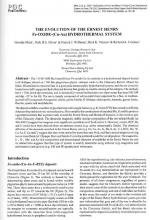Добрый день, Коллеги. Важное сообщение, просьба принять участие. Музей Ферсмана ищет помощь для реставрационных работ в помещении. Подробности по ссылке
The evolution of the Ernest Henry Fe-oxide-(-Cu-Au) hydrothermal system
The >1510-1500 Ma Ernest Henry Fe-oxide-Cu-Au orebody is a hydrothermal deposit hosted in K-feldspar altered ca 1740 Ma plagioclase phyric volcanic rocks in the Cloncurry district, Mount Isa Inlier. Mineralization occurred late in a post-peak metamorphic hydrothermal system, and the ore is mainly hosted in an infill-supported hydrothermal breccia that grades to crackle veining at the margins. The orebody has a > 1km down dip extension, and is structurally-controlled between two shear zones that trend NE-SW and dip -35° to the SE. The ore is mainly composed of subrounded clasts separated by a fine- to medium-grained infill composed of magnetite, calcite, pyrite, biotite, K-feldspar, chalcopyrite, hematite, garnet, barite, fluorite, quartz and molybdenite.
The deposit exhibits a number of geochemical and isotopic haloes (e.g. K, S and 5lxO) that extend to different distances beyond economic mineralization. Most notably the combination of enriched Mn, K and Ba produce a geochemical halo that is present only around the Ernest Henry and Monakoff deposits, in the northern part of the Cloncurry district. The dominant magmatic stable isotope composition of the ore-related fluids (ca 400-450°C) suggest that magmas were significant contributors of fluid and/or S. However, metals, REE, Ba and U could have been derived from an alternate source (e.g. saline metamorphic fluids). The chemical affinities of the elements enriched in the Ernest Henry ore (e.g. Fe, Cu, Au, K, Ba, S, As, U, LREE, Mo, W, Co, As, F, Ca and C) suggest that they were carried by more than one fluid, and that a mixed origin involving two or more fluids (cf. Olympic Dam and Salobo Cu) is the preferred model for ore deposition. The magnetite-U-, K-, Mo- and As-rich composition and disseminated character of sulphides in the Ernest Henry ore and its related halo suggests that this type of system is readily detectable using airborne (e.g. magnetics and radiometrics) and ground (e.g. EM and IP) geophysical techniques.




